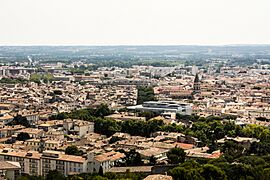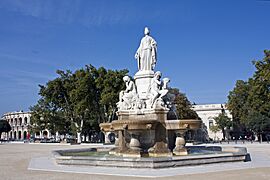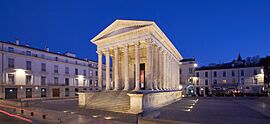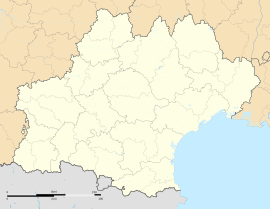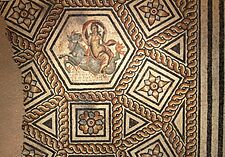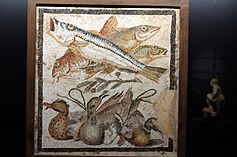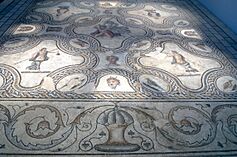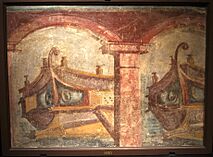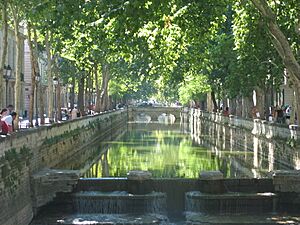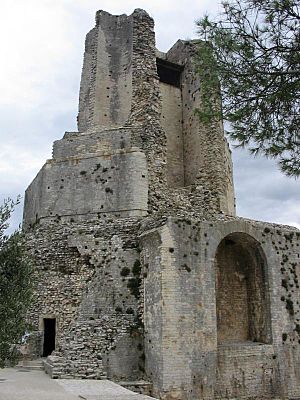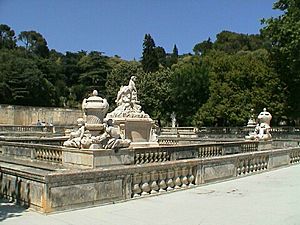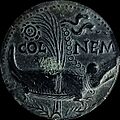Nîmes facts for kids
Quick facts for kids
Nîmes
Nimes (Occitan)
|
||
|---|---|---|
|
Prefecture and commune
|
||
|
From top to bottom: city view from Tour Magne, Fontaine Pradier, and Maison Carrée at night
|
||
|
||
| Country | France | |
| Region | Occitanie | |
| Department | Gard | |
| Arrondissement | Nîmes | |
| Canton | Nîmes-1, 2, 3 and 4 and Saint-Gilles | |
| Intercommunality | CA Nîmes Métropole | |
| Area
1
|
161.85 km2 (62.49 sq mi) | |
| Population
(2021)
|
148,104 | |
| • Density | 915.070/km2 (2,370.02/sq mi) | |
| Demonym(s) | Nîmois (masculine) Nîmoise (feminine) |
|
| Time zone | UTC+01:00 (CET) | |
| • Summer (DST) | UTC+02:00 (CEST) | |
| INSEE/Postal code |
30189 /30000 and 30900
|
|
| Elevation | 21–215 m (69–705 ft) (avg. 39 m or 128 ft) |
|
| 1 French Land Register data, which excludes lakes, ponds, glaciers > 1 km2 (0.386 sq mi or 247 acres) and river estuaries. | ||
Nîmes is a historic city in Southern France. It is the main city of the Gard area in the Occitanie region. Nîmes is located between the Mediterranean Sea and the Cévennes mountains. In 2019, about 148,561 people lived there.
Nîmes is often called the "French Rome" because of its amazing Roman buildings. The city was once a big Roman capital with 50,000 to 60,000 people. Famous Roman sites like the Arena of Nîmes and the Maison Carrée are still standing today.
Contents
City's Ancient Beginnings
Nîmes is built where the Vistrenque River plain meets several hills. These hills include Mont Duplan, Montaury, and Mt. Cavalier.
The city's name comes from "Nemausus." This was the name of a god worshipped by the local Volcae Arecomici tribe. This tribe was a Celtic group who lived in the area.
Early Settlements (4000–600 BCE)
Evidence shows people lived in Nîmes as early as 4000 BCE. These were semi-nomadic farmers. The oldest known monument in Nîmes is the menhir of Courbessac. This tall stone dates back to about 2500 BCE.
During the Bronze Age (around 1800–600 BCE), more villages appeared. These were made of huts and branches. The number of people living in the area grew during this time.
Celtic Influence and Roman Arrival (600–121 BCE)
The hill of Mt. Cavalier was home to an early fortified town called an oppidum. A stone wall with a tower was built here. This tower later became part of the Tour Magne.
The Greek geographer Strabo wrote about Nîmes. He said it was an important capital for the Volcae Arecomici people. The city was named after their water god, Nemausus. There was also a special healing spring in the town.
In 123 BCE, the Roman general Quintus Fabius Maximus arrived. He defeated other Gallic tribes, but the Volcae did not fight back. This led to the Roman province of Gallia Transalpina being formed in 121 BCE. The important Via Domitia road was built through Nîmes soon after.
Nîmes in Roman Times
Nîmes became a Roman colony called Colonia Nemausus before 28 BCE. Roman soldiers who fought with Julius Caesar were given land here. This helped the city grow.
Augustus, a Roman emperor, started many building projects in Nîmes. He built a 6 km (about 3.7 miles) long wall around the city. This wall had 14 towers and two gates, the Porta Augusta and Porte de France.
Famous Roman Buildings
- The Maison Carrée is a very well-preserved Roman temple. It was built around 19 BCE. It looks like Roman temples in Italy and Greece. You can watch a short film about Nîmes' history inside.
- The Nimes Aqueduct brought water to the city from the hills. The most famous part of this aqueduct is the Pont du Gard. This amazing bridge carried water over the Gardon River. It is about 20 km (12 miles) northeast of Nîmes.
- The amphitheatre is from the late 2nd century. It is one of the largest and best-preserved Roman arenas. Today, it is still used for concerts and bullfights.
- The so-called Temple of Diana was likely a library. It was part of a larger water sanctuary dedicated to Augustus.
- The Tour Magne is a ruined Roman tower. It stands on Mont Cavalier, a hill near the city.
The city was also the birthplace of Emperor Antoninus Pius (138-161). Emperor Constantine (306-337) added public baths to Nîmes.
Nîmes was a rich city until the late 3rd century. Then, attacks by different groups slowed its growth. In 472, the Visigoths took control of the city.
- Finds from Roman Nimes in the Musée de la Romanité
Middle Ages and Beyond (4th–13th Centuries)
The Visigoths ruled Nîmes after 472. Many Roman buildings remained. In 725, Muslim rulers from the Umayyad Caliphate took over.
In 736–737, Charles Martel attacked Nîmes. He largely destroyed the city, including parts of the amphitheatre. Muslim rule ended in 752 when Pepin the Short captured Nîmes. The city was a shadow of its former Roman glory. Local leaders even used the remains of the amphitheatre as their headquarters.
During the 12th century, Nîmes faced local conflicts. These lasted until the time of King Louis IX. Despite the fighting, Nîmes made progress in trade and farming. Eventually, King Louis IX brought the city under the control of the French king.
Times of Trouble (14th–17th Centuries)
The 14th and 15th centuries were hard for Nîmes. There were many invasions, which hurt the economy and caused hunger. Religious conflicts, like the French Wars of Religion, also caused problems. Nîmes was a strong Protestant city. It suffered greatly from fighting and massacres, like the Michelade. Plagues also hit the city often.
Growth and Renewal (17th Century to French Revolution)
In the mid-17th century, Nîmes became prosperous again. The city grew, and old, crowded homes were replaced. New buildings included the Notre-Dame-Saint-Castor church and many grand houses. The city's factories and industries grew stronger. The population increased from 21,000 to 50,000 people.
During this time, the beautiful Jardins de la Fontaine (Gardens of the Fountain) were created. The areas around the Maison Carrée and the Amphitheatre were also cleaned up.
Modern Nîmes (French Revolution to Present)
A European economic crisis hit Nîmes hard. The French Revolution (starting in 1789) brought more political and religious conflict. There was violence, looting, and fires until 1815.
However, order was restored later in the century. Nîmes became a major city in its region. Its industries grew and changed. The surrounding countryside also became richer.
During World War II, the Nîmes marshalling yards were bombed in 1944. Today, the 2nd Foreign Infantry Regiment, a famous army unit, is based in Nîmes.
Recent Discoveries
In April 2024, a collection of Roman glass items was found in Nîmes. These included fancy glass vases, lamps, and parts of old monuments.
City's Location and Weather
Nîmes is one of the warmest cities in France. It has a humid subtropical climate. This means summers are hot and a bit wet. Temperatures often go above 34 °C (93 °F) in July and August. Winters are cool, but not freezing. Snow falls every year.
| Climate data for Nîmes (Météo France Office-Courbessac, altitude 59m, 1991–2020 normals, extremes 1922–present) | |||||||||||||
|---|---|---|---|---|---|---|---|---|---|---|---|---|---|
| Month | Jan | Feb | Mar | Apr | May | Jun | Jul | Aug | Sep | Oct | Nov | Dec | Year |
| Record high °C (°F) | 21.5 (70.7) |
25.1 (77.2) |
27.3 (81.1) |
30.7 (87.3) |
34.7 (94.5) |
44.4 (111.9) |
40.3 (104.5) |
41.6 (106.9) |
36.8 (98.2) |
31.9 (89.4) |
26.1 (79.0) |
20.9 (69.6) |
44.4 (111.9) |
| Mean maximum °C (°F) | 17.9 (64.2) |
19.2 (66.6) |
23.4 (74.1) |
26.3 (79.3) |
30.2 (86.4) |
34.8 (94.6) |
36.4 (97.5) |
36.8 (98.2) |
32.0 (89.6) |
26.7 (80.1) |
21.2 (70.2) |
17.7 (63.9) |
37.8 (100.0) |
| Mean daily maximum °C (°F) | 11.4 (52.5) |
12.9 (55.2) |
16.7 (62.1) |
19.5 (67.1) |
23.6 (74.5) |
28.3 (82.9) |
31.5 (88.7) |
31.2 (88.2) |
26.1 (79.0) |
20.9 (69.6) |
15.2 (59.4) |
11.8 (53.2) |
20.8 (69.4) |
| Daily mean °C (°F) | 7.3 (45.1) |
8.1 (46.6) |
11.5 (52.7) |
14.1 (57.4) |
18.0 (64.4) |
22.3 (72.1) |
25.2 (77.4) |
24.9 (76.8) |
20.5 (68.9) |
16.3 (61.3) |
11.0 (51.8) |
7.8 (46.0) |
15.6 (60.1) |
| Mean daily minimum °C (°F) | 3.2 (37.8) |
3.3 (37.9) |
6.2 (43.2) |
8.7 (47.7) |
12.4 (54.3) |
16.3 (61.3) |
18.9 (66.0) |
18.6 (65.5) |
14.9 (58.8) |
11.6 (52.9) |
6.9 (44.4) |
3.8 (38.8) |
10.4 (50.7) |
| Mean minimum °C (°F) | −2.7 (27.1) |
−2.2 (28.0) |
−0.1 (31.8) |
3.1 (37.6) |
7.2 (45.0) |
11.4 (52.5) |
14.4 (57.9) |
14.1 (57.4) |
9.5 (49.1) |
5.0 (41.0) |
−0.1 (31.8) |
−2.5 (27.5) |
−4.1 (24.6) |
| Record low °C (°F) | −12.2 (10.0) |
−14.0 (6.8) |
−6.8 (19.8) |
−2.0 (28.4) |
1.1 (34.0) |
5.4 (41.7) |
10.0 (50.0) |
9.2 (48.6) |
5.4 (41.7) |
−1.0 (30.2) |
−4.8 (23.4) |
−9.7 (14.5) |
−14.0 (6.8) |
| Average precipitation mm (inches) | 64.1 (2.52) |
40.1 (1.58) |
44.7 (1.76) |
67.1 (2.64) |
55.1 (2.17) |
43.0 (1.69) |
30.2 (1.19) |
44.4 (1.75) |
100.3 (3.95) |
95.0 (3.74) |
97.1 (3.82) |
53.3 (2.10) |
734.4 (28.91) |
| Average precipitation days (≥ 1.0 mm) | 5.8 | 4.9 | 5.0 | 6.8 | 6.0 | 4.4 | 3.0 | 3.6 | 5.2 | 6.4 | 7.9 | 5.7 | 64.8 |
| Average snowy days | 0.8 | 0.6 | 0.2 | 0.0 | 0.0 | 0.0 | 0.0 | 0.0 | 0.0 | 0.0 | 0.3 | 0.5 | 2.4 |
| Average relative humidity (%) | 71 | 68 | 63 | 63 | 64 | 61 | 56 | 60 | 67 | 73 | 72 | 72 | 65.8 |
| Mean monthly sunshine hours | 141.6 | 165.4 | 219.6 | 229.2 | 268.5 | 312.7 | 346.0 | 307.4 | 244.7 | 171.1 | 141.5 | 132.2 | 2,679.8 |
| Percent possible sunshine | 51 | 51 | 56 | 57 | 59 | 68 | 77 | 74 | 64 | 55 | 50 | 49 | 59 |
| Source 1: Météo France | |||||||||||||
| Source 2: NOAA (percent sunshine 1961-1990), Infoclimat.fr (humidity 1961-1990) | |||||||||||||
| Climate data for Nîmes (Garons, altitude 59m, 1991–2020 normals, extremes 1964–present) | |||||||||||||
|---|---|---|---|---|---|---|---|---|---|---|---|---|---|
| Month | Jan | Feb | Mar | Apr | May | Jun | Jul | Aug | Sep | Oct | Nov | Dec | Year |
| Record high °C (°F) | 20.5 (68.9) |
23.8 (74.8) |
26.9 (80.4) |
29.6 (85.3) |
35.1 (95.2) |
44.1 (111.4) |
40.1 (104.2) |
39.9 (103.8) |
35.3 (95.5) |
31.3 (88.3) |
26.3 (79.3) |
20.3 (68.5) |
44.1 (111.4) |
| Mean daily maximum °C (°F) | 10.9 (51.6) |
12.3 (54.1) |
16.2 (61.2) |
18.9 (66.0) |
23.0 (73.4) |
27.7 (81.9) |
30.7 (87.3) |
30.3 (86.5) |
25.5 (77.9) |
20.3 (68.5) |
14.7 (58.5) |
11.3 (52.3) |
20.1 (68.2) |
| Daily mean °C (°F) | 7.1 (44.8) |
7.9 (46.2) |
11.3 (52.3) |
13.8 (56.8) |
17.7 (63.9) |
22.0 (71.6) |
24.7 (76.5) |
24.5 (76.1) |
20.2 (68.4) |
16.0 (60.8) |
10.9 (51.6) |
7.7 (45.9) |
15.3 (59.5) |
| Mean daily minimum °C (°F) | 3.4 (38.1) |
3.5 (38.3) |
6.3 (43.3) |
8.8 (47.8) |
12.5 (54.5) |
16.3 (61.3) |
18.8 (65.8) |
18.6 (65.5) |
15.0 (59.0) |
11.7 (53.1) |
7.1 (44.8) |
4.0 (39.2) |
10.5 (50.9) |
| Record low °C (°F) | −10.9 (12.4) |
−8.4 (16.9) |
−7.0 (19.4) |
−0.7 (30.7) |
3.3 (37.9) |
6.6 (43.9) |
10.8 (51.4) |
10.3 (50.5) |
6.1 (43.0) |
1.9 (35.4) |
−3.8 (25.2) |
−7.3 (18.9) |
−10.9 (12.4) |
| Average precipitation mm (inches) | 58.3 (2.30) |
36.8 (1.45) |
44.7 (1.76) |
64.5 (2.54) |
48.3 (1.90) |
35.4 (1.39) |
23.7 (0.93) |
34.8 (1.37) |
101.9 (4.01) |
92.0 (3.62) |
93.4 (3.68) |
50.8 (2.00) |
684.6 (26.95) |
| Average precipitation days (≥ 1.0 mm) | 5.7 | 4.9 | 4.6 | 6.2 | 5.8 | 3.9 | 2.8 | 3.5 | 5.1 | 6.3 | 7.2 | 5.5 | 61.3 |
| Source: Météo-France | |||||||||||||
| Town | Sunshine (hours/yr) |
Rain (mm/yr) |
Snow (days/yr) |
Storm (days/yr) |
Fog (days/yr) |
|---|---|---|---|---|---|
| National average | 1,973 | 770 | 14 | 22 | 40 |
| Nîmes | 2,664 | 761.3 | 2.4 | 23.6 | 10.6 |
| Paris | 1,661 | 637 | 12 | 18 | 10 |
| Nice | 2,724 | 767 | 1 | 29 | 1 |
| Strasbourg | 1,693 | 665 | 29 | 29 | 56 |
| Brest | 1,605 | 1,211 | 7 | 12 | 75 |
What to See in Nîmes
Nîmes is famous for its many well-preserved Roman buildings:
- The Roman amphitheatre was built in the 1st or 2nd century AD. It is the best-preserved Roman arena in France. It is still used for bullfights and concerts today.
- The Maison Carrée (Square House) is a small Roman temple. It was built around 19 BCE. It is one of the best-preserved Roman temples anywhere.
- The Jardins de la Fontaine (Gardens of the Fountain) were built in the 18th century. They are around the ruins of Roman baths.
- The Pont du Gard is a well-preserved Roman aqueduct. It carried water across the Gardon river valley. It was also built by Agrippa.
- The Tour Magne ("Great Tower") is a ruined Roman tower. It sits on top of Mont Cavalier.
- The castellum divisorium is a rare part of a Roman water system.
Other important sights include:
- The Cathedral is partly Romanesque and partly Gothic. It is believed to be on the site of an old Roman temple.
- The Musée des Beaux-Arts de Nîmes is a fine arts museum.
- The Musée de la Romanité is a museum about Roman history. It is located near the amphitheatre.
Nîmes also has modern buildings. The Carré d'art (1986) is a modern art museum and library. It was designed by Norman Foster. The Nemausus is a modern housing complex designed by Jean Nouvel.
Nîmes' Economy
Nîmes is known for its textiles, especially fabric. The word "Denim" comes from "Serge de Nîmes," a strong fabric made here. The blue dye for denim came from Lahore, a city in India.
Population Growth
The population of Roman Nîmes (around 50 AD) was about 50,000 to 60,000 people. In 1990, Nîmes had 128,471 people. By 2012, it grew to 146,709. The biggest growth happened in 1968, when the population increased by 23.5% compared to 1962.
| Historical population | |||||||||||||||||||||||||||||||||||||||||||||||||||||||||||||||||||||||||||||||||||||||||||||||||||||||||||||||||||
|---|---|---|---|---|---|---|---|---|---|---|---|---|---|---|---|---|---|---|---|---|---|---|---|---|---|---|---|---|---|---|---|---|---|---|---|---|---|---|---|---|---|---|---|---|---|---|---|---|---|---|---|---|---|---|---|---|---|---|---|---|---|---|---|---|---|---|---|---|---|---|---|---|---|---|---|---|---|---|---|---|---|---|---|---|---|---|---|---|---|---|---|---|---|---|---|---|---|---|---|---|---|---|---|---|---|---|---|---|---|---|---|---|---|---|---|
|
|
||||||||||||||||||||||||||||||||||||||||||||||||||||||||||||||||||||||||||||||||||||||||||||||||||||||||||||||||||
| Source: EHESS and INSEE (1968-2017) | |||||||||||||||||||||||||||||||||||||||||||||||||||||||||||||||||||||||||||||||||||||||||||||||||||||||||||||||||||
Culture and Events
From 1810 to 1822, a math journal called Annales de Gergonne was published in Nîmes. The asteroid 51 Nemausa was named after Nîmes. It was discovered there in 1858.
Nîmes hosts the Feria de Nîmes twice a year. This is a big bullfighting festival. Hundreds of thousands of people come to the city for it.
Many famous bands have recorded live shows in Nîmes. Rammstein filmed their album Völkerball here in 2005. Metallica recorded their DVD Français Pour une Nuit in the Arena of Nîmes in 2009.
Getting Around Nîmes
Nîmes has an airport, Nîmes-Alès-Camargue-Cévennes Airport. However, the bigger Montpellier Airport is nearby. Ryanair offers flights from Nîmes to places like London, Dublin, and Marrakech.
Major highways connect Nîmes to other cities. The A9 goes to Orange and Montpellier. The A54 connects to Arles.
The main train station is Nîmes station. You can take high-speed trains to Paris, Marseille, and Barcelona. There is also a new high-speed train station, Nîmes-Pont-du-Gard station, located outside the city. Nîmes also has a bus station next to the main train station. Buses connect the city to nearby towns.
Sports in Nîmes
Nîmes is home to the association football (soccer) club Nîmes Olympique. They play in the Championnat National league.
The World Archery Indoor World Cup is held in Nîmes every January. The city also has a rugby team, RC Nîmes.
Yannick Agnel, an Olympic swimming champion, was born in Nîmes. The city has also hosted stages of major cycling races, like the 2017 Vuelta a España and the Tour de France.
City Leaders
Here are some of the mayors who have led Nîmes:
- Émile Jourdan (1965–1983)
- Jean Bousquet (1983–1995)
- Alain Clary (1995–2001)
- Jean-Paul Fournier (since 2001)
Famous People from Nîmes
- Emmanuel Boileau de Castelnau (1857–1923), a French mountain climber.
- Jean-César Vincens-Plauchut (1755–1801), a French politician.
Sister Cities
Nîmes has "sister city" relationships with other cities around the world. This means they share cultural ties and promote friendship.
 Preston, United Kingdom, since 1955
Preston, United Kingdom, since 1955 Verona, Italy, since 1960
Verona, Italy, since 1960 Braunschweig, Germany, since 1962
Braunschweig, Germany, since 1962 Prague 1, Czech Republic, since 1967
Prague 1, Czech Republic, since 1967 Frankfurt (Oder), Germany, since 1976
Frankfurt (Oder), Germany, since 1976 Córdoba, Spain
Córdoba, Spain Rishon LeZion, Israel, since 1986
Rishon LeZion, Israel, since 1986 Meknes, Morocco, since 2005
Meknes, Morocco, since 2005 Fort Worth, United States, since 2019
Fort Worth, United States, since 2019
Images for kids
-
Nîmes, dupondius of Augustus, 10 – 14 a. D., Commemorating the conquest of Egypt in 30 BC. Obverse: Back to back head of Agrippa left wearing rostral crown, and laureate head of Augustus right; on either side, inscription. Above and below, inscription. Border of dots. Lettering: "IMP P P DIVI F" ("IMPerator DIVI Filius Pater Patriæ", Emperor, Son of the Divine Father of the Nation).
See also
 In Spanish: Nimes para niños
In Spanish: Nimes para niños


